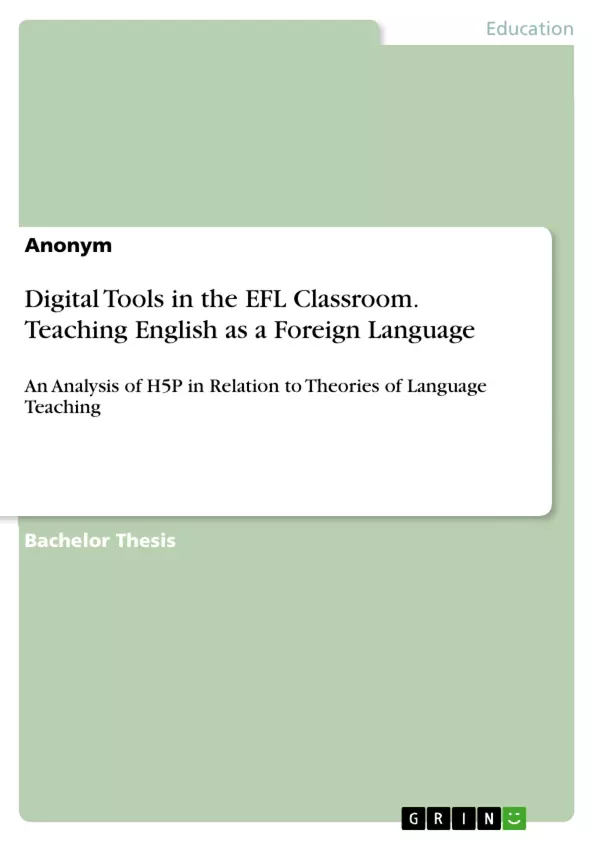This thesis raises the questions why we need digitalization, what it can offer, and analyses how it can be implemented in the classroom.
In order to answer this question thoroughly and analyse the software in great detail, the first chapter of this thesis lays the theoretical basis for some didactic theories. The second chapter provides insights on digitalization, in context with multiliteracies and the SAMR-model. In chapter three, the analyzation of the software H5P answers the initially raised questions.
The COVID-19 pandemic put the spotlight to schools and the school system in general. After 18 months of homeschooling and remote education it became obvious, that digitalization had not reached the classroom before and very little progress has been achieved until now. Even though theoretically digital tools were available, it lacked on a working infrastructure in schools in the sense of Wi-Fi, hardware or well-trained teachers. Whether it is for the missing devices as a result of the paperwork to apply for the ‘Digitalpakt Schule’, because of the missing reasons to deal with digitalization in schools as such, or because the teachers are not trained enough to use them; digitalization in schools did not seem necessary, nor wanted, and that was no subject to change for a long time.
In the last few years loads of books, training courses for teachers, congresses, blogs and tweets appeared and at least theoretically digitalization reached schools and classrooms. It seems that ‘digitalization in the English language classroom’ has finally reached teacher education programs at universities and raises a whole new generation of teachers. Not only future teachers, but also current ones should be keen to know why years ago schools stopped to keep up with digitalization, why it needs to be implemented in schools, what it offers, where its limitations are and how traditional teaching methods can be modified into digital settings.
Inhaltsverzeichnis (Table of Contents)
- 1. Introduction
- 2. SLA Theories and EFL Methods in CALL.
- 2.1. Behaviorist Stage of SLA in CALL.
- 2.2. Communicative Stage of SLA in CALL
- 2.3. Task-Based Approach
- 2.3.1 Digitally Mediated Task-Based Approach (Tasks 2.0)
- 3. Digital Change in the EFL Classroom.......
- 3.1 Background and Importance..
- 3.2 Multiliteracies
- 3.3 SAMR-Model.
- 4. H5P Analysis...
- 4.1 General Information on H5P
- 4.2 Possibilities and Limitations in using H5P.
- 4.3 Examples.
- 4.3.1 Grammar Exercise.
- 4.3.2 Project work / Writing Task.
- 4.4 To sum it up.
- 5. Conclusion........
Zielsetzung und Themenschwerpunkte (Objectives and Key Themes)
This thesis explores the role of digital tools, specifically H5P, in teaching English as a Foreign Language (EFL). The focus is on analyzing H5P's potential and limitations within the context of existing theories of Second Language Acquisition (SLA) and EFL methods in Computer Assisted Language Learning (CALL). The primary objective is to demonstrate how H5P can be effectively integrated into EFL classrooms to enhance student learning.
- The impact of digitalization on EFL education
- The application of SLA theories in CALL environments
- The integration of H5P as a digital tool in EFL classrooms
- The analysis of H5P's strengths and weaknesses
- The exploration of H5P's suitability for various EFL tasks
Zusammenfassung der Kapitel (Chapter Summaries)
- Chapter 1: Introduction: This chapter introduces the context for the thesis, highlighting the increasing importance of digitalization in education, particularly in EFL classrooms. It discusses the need for teachers to embrace digital tools and adapt traditional teaching methods to digital settings.
- Chapter 2: SLA Theories and EFL Methods in CALL.: This chapter explores key theories of Second Language Acquisition (SLA) and their relevance to EFL methods in Computer Assisted Language Learning (CALL). It examines how these theories have shaped the development and use of digital tools in language learning.
- Chapter 3: Digital Change in the EFL Classroom: This chapter discusses the broader implications of digital change in the EFL classroom. It examines the concept of multiliteracies and explores the SAMR model, a framework for understanding the integration of technology in education.
- Chapter 4: H5P Analysis: This chapter focuses on the analysis of the software H5P. It provides general information about the tool, explores its potential and limitations for EFL learning, and presents examples of its use in different contexts, such as grammar exercises and project work.
Schlüsselwörter (Keywords)
The primary focus of this thesis revolves around digitalization, EFL education, SLA theories, CALL methods, H5P software, and its application within the EFL classroom. The work investigates the benefits and challenges of integrating this digital tool into traditional teaching practices, examining its effectiveness in enhancing language learning outcomes.
- Citation du texte
- Anonym (Auteur), 2021, Digital Tools in the EFL Classroom. Teaching English as a Foreign Language, Munich, GRIN Verlag, https://www.grin.com/document/1176177



